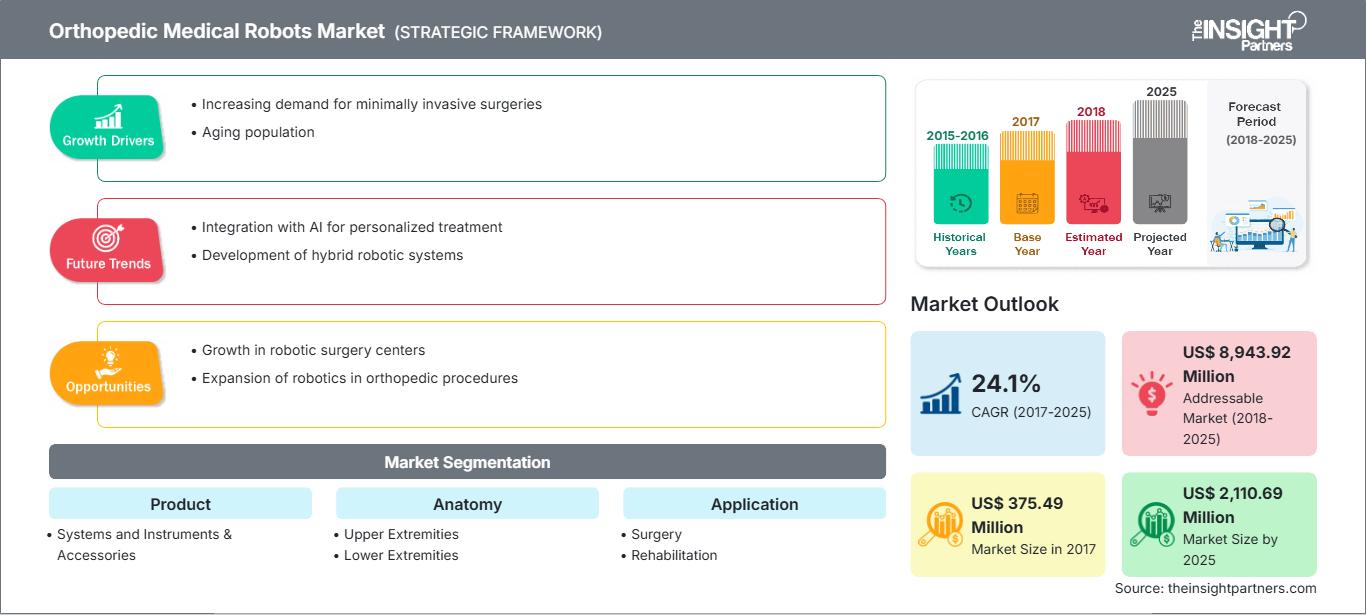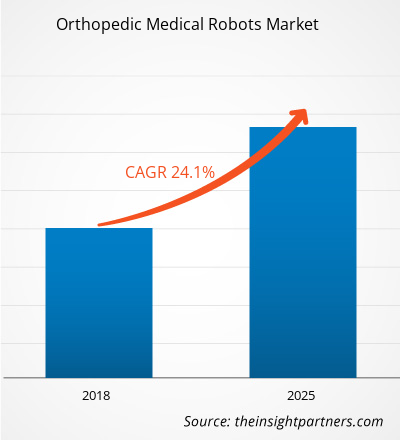2017 年骨科医疗机器人市场价值为 3.7549 亿美元,预计到 2025 年将达到 21.1069 亿美元;预计 2018 年至 2025 年的复合年增长率为 24.1%。
骨科医疗机器人是指医疗机构用来协助医生进行骨科手术以及术后护理和康复的机器人系统和设备。此外,自动导引车还可在手术和辅助护理过程中用作起重辅助工具。骨科医疗机器人市场的增长归因于肌肉骨骼疾病数量的增加,用于医疗机器人研究的资金增加以及骨科手术机器人的技术发展预计将成为全球骨科医疗机器人市场的主要驱动力。然而,与机器人系统相关的高成本和安全问题可能会在一定程度上抑制市场的增长。此外,患者对机器人辅助手术的偏好增加以及医疗保健市场的发展可能会对未来几年骨科医疗机器人市场的增长产生积极影响。
预计骨科医疗机器人市场将在疫情后出现大幅增长。预计骨科医疗机器人市场将在疫情后出现大幅增长。由于封锁、旅行禁令和企业倒闭,COVID-19 影响了各国的经济和行业。COVID-19 危机使许多国家的公共卫生系统不堪重负,凸显了对卫生系统可持续投资的强烈需求。随着 COVID-19 疫情的进展,预计医疗保健行业的增长将下降。由于对体外诊断产品的需求增加以及全球研发活动的增加,生命科学领域蓬勃发展。然而,由于手术数量减少以及设备采购延迟或延期,医疗技术和影像领域的销售额正在下降。此外,预计医护人员的虚拟会诊将成为疫情后主流的医疗服务模式。随着远程医疗彻底改变医疗服务模式,数字医疗将在未来几年继续蓬勃发展。此外,临床试验的中断以及随之而来的药物上市延迟,预计也将为未来完全虚拟的试验铺平道路。mRNA 等新技术预计将出现并改变制药行业,预计未来几年市场也将出现更多的垂直整合和合资企业。
自定义此报告以满足您的要求
您将免费获得任何报告的定制,包括本报告的部分内容,或国家级分析、Excel 数据包,以及为初创企业和大学提供超值优惠和折扣
骨科医疗机器人市场: 战略洞察

- 获取本报告的主要市场趋势。这个免费样本将包括数据分析,从市场趋势到估计和预测。
您将免费获得任何报告的定制,包括本报告的部分内容,或国家级分析、Excel 数据包,以及为初创企业和大学提供超值优惠和折扣
骨科医疗机器人市场: 战略洞察

- 获取本报告的主要市场趋势。这个免费样本将包括数据分析,从市场趋势到估计和预测。
市场洞察
骨科医疗机器人在医疗保健领域的应用日益广泛,推动骨科医疗机器人在医疗保健市场的增长
肌肉骨骼疾病涵盖超过 150 种诊断,影响肌肉、骨骼、关节、肌腱和韧带的运动系统。这些疾病范围广泛,从突发且短暂的骨折、扭伤和拉伤,到与残疾和持续疼痛相关的终身疾病。大多数肌肉骨骼疾病的特征是疼痛、活动能力、灵活性和功能能力受限,从而降低人们的工作能力和参与社会角色的能力,并影响心理健康,在更广泛的层面上影响社区的繁荣。肌肉骨骼疾病影响着世界各地人们的整个生命历程。虽然肌肉骨骼疾病的患病率会随着年龄增长而增加,但年轻人也会受到影响,尤其是在他们收入最高的年龄段。据世界卫生组织 (WHO) 称,预计随着全球人口老龄化以及非传染性疾病 (NCD) 风险因素患病率的上升,肌肉骨骼疾病的患病率和影响也会上升。
根据世界卫生组织 2018 年的情况说明书,肌肉骨骼疾病是全球第二大致残因素,而腰痛是全球第一大致残原因。此外,根据全球疾病负担 (GBD),肌肉骨骼疾病 (MSD) 的影响凸显了其沉重的负担,在其 2016 年的研究报告中,肌肉骨骼疾病是致残相关负担的第二大原因。此外,WHO 还报告称,全球有 20% 至 33% 的人患有疼痛的肌肉骨骼疾病。肌肉骨骼疾病是美国最常见的导致严重、长期疼痛和残疾的原因之一。根据美国骨科医师学会 (ASOS) 的数据,2016 年估计有 1.266 亿美国人患有肌肉骨骼疾病。此外,根据美国骨科医师学会 2016 年年会发布的数据,美国约有一半的成年人患有肌肉骨骼疾病。鉴于肌肉骨骼疾病的影响日益显著,导航和机器人技术在膝关节、髋关节和脊柱损伤等骨科问题中的应用有望蓬勃发展,并见证其在未来治疗和患者护理中的重要作用。
肌肉骨骼疾病的增多直接导致了全球骨科手术数量的增加。根据美国关节置换外科协会 2017 年的报告,美国 654 家医疗机构共有 4,755 名外科医生实施了约 860,080 例髋关节和膝关节置换手术。此外,根据《骨与关节外科杂志》2015 年的报道,约有 700 万美国人接受了髋关节或膝关节置换手术,因此,尽管患有晚期关节炎,但大多数情况下他们仍能活动。这些数字凸显了全髋关节和膝关节置换术对公共健康的巨大影响。亚洲国家也出现了骨科手术数量增多的趋势。根据国际骨质疏松症基金会 (IOF) 的数据,中国每年约有 60 万例髋部骨折需要紧急救治。患者数量的增加推动了全球骨科医疗机器人的发展。
借助各种人工智能 (AI) 支持系统,医疗机器人可以帮助外科医生提高效率和准确性,从而改善患者的治疗效果、提高治疗过程的效率和准确性。医疗机器人正在引发治疗领域的范式转变。就像任何技术驱动革命的初始阶段一样,医疗机器人的新用途也在不断涌现。
到目前为止,骨科机器人的目标是髋关节和膝关节进行置换或表面置换。然而,用于各种上肢手术的机器人系统仍处于早期阶段,尚未实现令人信服的商业化。因此,增加对医疗机器人领域的投资可能会产生充足的收入来开展这些研究,从而将新系统引入市场,从而推动全球骨科医疗机器人市场的发展。
医疗机器人领域的创新使得识别、发明、研究和实施能够在正确的时间为正确的患者提供正确治疗的技术成为可能。此外,机器人技术在改变治疗方式、患者护理和医疗设施可及性方面具有巨大潜力,这促使投资者向制造商和研究人员提供大量资金。例如,2018 年 7 月,OrthoSpin Ltd. 宣布该公司完成了 300 万美元的投资,用于其用于骨科治疗的智能机器人外固定系统。
此外,2018 年 6 月,开发下一代手术机器人的英国公司 CMR Surgical Ltd 宣布已完成 B 轮融资,从新投资者浙江丝路基金和现有投资者 Escala Capital Investments、LGT、Cambridge Innovation Capital 和 Watrium 筹集了 1 亿美元。 Versius 系统旨在充当四轴腕关节,其设计灵感源自人类手臂,旨在满足腹腔镜手术的需求。国内外投资者在骨科医疗机器人领域的巨额投资有望在未来几年支撑全球市场的增长。
现代手术不仅依赖于熟练专业人员的实践,还依赖于基于尖端技术的先进手术设备的合理使用,以获得有效且精准的治疗效果。与其他创新概念类似,骨科机器人和导航技术仍处于过渡阶段,新系统和先进技术会相对滞后地引入市场。研究人员和制造商正在大力投资这些机器人系统的设计和概念化,以减轻护理人员的工作负担,并为骨科患者提供创新的解决方案。最近推出的系统规避了这一要求,允许将模板直接应用于关节表面,从而实现微创技术。许多系统都采用了类似的基本原理。
这些系统的制造商始终致力于通过改进骨科机器人的技术,帮助世界各地的外科医生以更便捷的可视化和重症监护管理,执行更优质、更精准、更复杂的手术。例如,2017年3月,史赛克公司推出了用于执行膝关节置换和部分膝关节置换手术的Mako机器人。继史赛克推出Mako机器人之后,施乐辉公司于2017年11月推出了一款经济高效的Navio机器人手术系统,与史赛克的Mako机器人相竞争,该系统提供部分膝关节和全膝关节两种手术选择。
一些领先的市场参与者已推出各自的产品,并可能在不久的将来推出采用最新创新和技术的系统。例如,在2017年于圣地亚哥举行的美国骨科医师学会年会上,捷迈邦美公司宣布将在2018年下半年推出一个用于执行全膝关节手术的机器人辅助手术平台。此外,强生公司也宣布,该公司计划在2018年下半年推出一个用于执行全膝关节手术的机器人辅助手术平台。强生计划通过收购 Orthotaxy Ltd. 进军骨科医疗机器人市场,Orthotaxy 目前正处于全膝关节和部分膝关节置换的早期开发阶段。因此,即将推出的全新尖端技术产品预计将在未来几年推动骨科医疗机器人市场的增长。
基于产品的洞察
就产品而言,骨科医疗机器人市场分为系统、器械和配件。2017 年,器械和配件部分占据了整个市场的最大份额,达到 60.7%,这归因于这些部件以及资本机器人系统的重复购买。
基于解剖学的洞察
根据解剖学,骨科医疗机器人市场分为上肢、下肢和其他。 2017 年,预计下肢机器人市场的复合年增长率为 24.6%。由于目前的骨科机器人系统主要用于执行下肢手术,因此按解剖结构划分,下肢机器人市场占据最大市场份额。
基于应用的洞察
根据应用,骨科医疗机器人市场可细分为手术、康复和其他领域。2017 年,预计手术市场的复合年增长率为 24.5%。由于市场上现有的骨科机器人主要用于执行手术任务,因此按应用划分,手术市场占据最大市场份额。
基于最终用户的洞察
就最终用户而言,骨科医疗机器人市场可细分为医院、骨科诊所和门诊手术中心。预计医院细分市场在预测期内的复合年增长率将达到 24.5%。按最终用户计算,医院细分市场占据最大的市场份额,达 53.6%。
骨科医疗机器人市场参与者正在采用产品发布和扩张策略,以满足全球不断变化的客户需求,同时也使他们能够在全球范围内维护自己的品牌。
骨科医疗机器人市场区域洞察
The Insight Partners 的分析师已详尽阐述了预测期内影响骨科医疗机器人市场的区域趋势和因素。本节还讨论了北美、欧洲、亚太地区、中东和非洲以及南美和中美洲的骨科医疗机器人市场细分和地域分布。
骨科医疗机器人市场报告范围
| 报告属性 | 细节 |
|---|---|
| 市场规模 2017 | US$ 375.49 Million |
| 市场规模 2025 | US$ 2,110.69 Million |
| 全球复合年增长率 (2017 - 2025) | 24.1% |
| 历史数据 | 2015-2016 |
| 预测期 | 2018-2025 |
| 涵盖的领域 |
By 产品
|
| 覆盖地区和国家 | 北美
|
| 市场领导者和主要公司简介 |
|
骨科医疗机器人市场参与者密度:了解其对业务动态的影响
骨科医疗机器人市场正在快速增长,这得益于终端用户需求的不断增长,而这些需求的驱动因素包括消费者偏好的演变、技术进步以及对产品优势的认知度的提升。随着需求的增长,企业正在扩展产品线,不断创新以满足消费者需求,并抓住新兴趋势,从而进一步推动市场增长。

- 获取 骨科医疗机器人市场 主要参与者概述
- 系统
- 仪器与配件
医疗保健市场中的骨科医疗机器人 — 按解剖结构分类
- 上肢
- 手
- 肘
- 腕
- 肩
- 下肢
- 膝盖
- 足与踝
- 臀部
- 其他
- 其他
医疗保健市场中的骨科医疗机器人 — 按应用分类
- 手术
- 康复
- 其他
医疗保健市场中的骨科医疗机器人 —
- 医院
- 骨科诊所
- 门诊手术中心
医疗保健市场中的骨科医疗机器人 – 按地域
北美
- 美国
- 加拿大
- 墨西哥
欧洲
- 法国
- 德国
- 意大利
- 英国
- 西班牙
- 欧洲其他地区
亚太地区 (APAC)
- 中国
- 印度
- 韩国
- 日本
- 澳大利亚
- 亚太地区其他地区
中东和非洲 (MEA)
- 南非
- 沙特阿拉伯
- 阿联酋
- MEA 其他地区
南美洲和中美洲 (SCAM)
- 巴西
- 阿根廷
- 其他 SCAM 地区
公司简介
- Smith & Nephew
- Stryker
- Medtronic
- Intuitive Surgical
- Ekso Bionics
- Zimmer Biomet
- Wright Medical Group NV
- General Electric
- THINK Surgical
- OMNI
- 历史分析(2 年)、基准年、预测(7 年)及复合年增长率
- PEST和SWOT分析
- 市场规模、价值/数量 - 全球、区域、国家
- 行业和竞争格局
- Excel 数据集
近期报告
相关报告
客户评价
购买理由
- 明智的决策
- 了解市场动态
- 竞争分析
- 客户洞察
- 市场预测
- 风险规避
- 战略规划
- 投资论证
- 识别新兴市场
- 优化营销策略
- 提升运营效率
- 顺应监管趋势




















 获取免费样品 - 骨科医疗机器人市场
获取免费样品 - 骨科医疗机器人市场